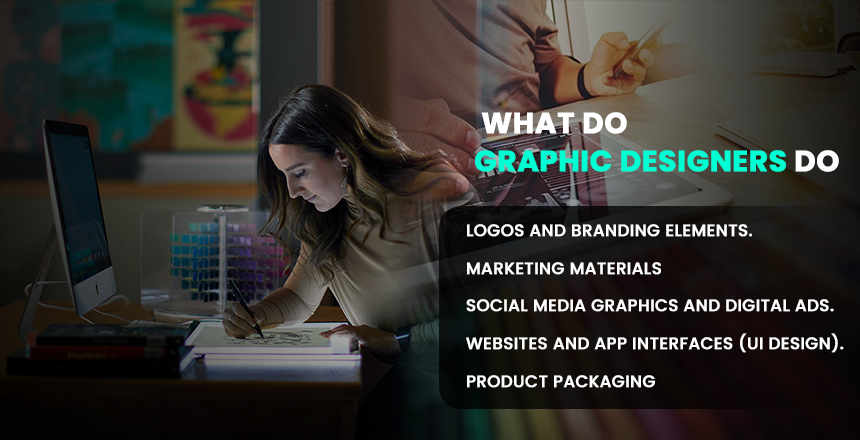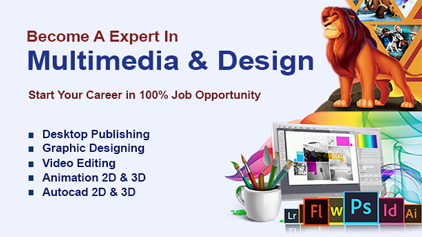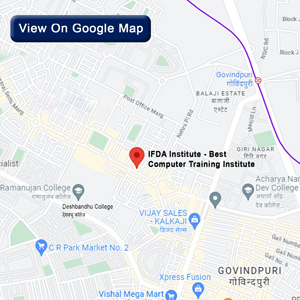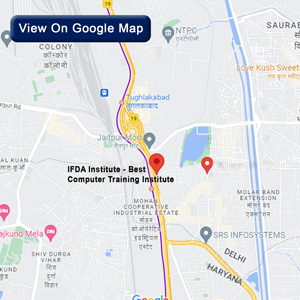What Do Graphic Designers Do

Graphic designers also have a central responsibility for creating the visual environment that surrounds us. Indeed, whether it is in the logos that we often associate with or the websites we browse throughout the day, their creative input is discernible. If you are interested in having a job as a graphic designer or if you have never heard about the job description before.
Understanding graphic design
Looking at the essence of graphic design, one will be able to tell that it is all about communicating and solving problems through the utilization of graphics. Graphic designers apply the principles of typography, images, colors, and arrangement to produce pictures and texts that pass on messages in the most appealing way possible. Through their work, one can change how a person thinks, feels, or even acts toward something.
Responsibilities of Graphic Designers.
Creating Visual Concepts:
Graphic designers create visuals that convey messages, persuade, educate, or entertain the target market. They make designs come up for discussion and elaboration that suit the client’s goals and the intended consumers.
Creating Visual Concepts:
Graphic designers create visuals that convey messages, persuade, educate, or entertain the target market. They make designs come up for discussion and elaboration that suit the client’s goals and the intended consumers.
Designing Layouts and Visual Elements:
Graphic designers work on formatting the image and text to be placed on print media, for websites, or for any other multimedia project they take up. This involves making choices on the type of font, color, pictures, and spaces between elements to make the design effective and aesthetically appealing.
Branding and Identity Design:
Graphic design works on the idea that one of the more significant responsibilities of designers is to develop and manage the image of a brand. It means coming up with badge materials such as logos, cards such as business cards, and other stationery that depict the brand personality.
Producing marketing materials:
Marketing communication products that graphic designers design include publications such as brochures, flyers, posters, banners, and advertisements. Such materials are meant to advertise a product, service, event, or campaign, as well as to capture and maintain customers.
Web and User Interface (UI) Design:
Well, with the advances in technology, most graphic designers are now involved in designing the layouts of websites and graphics, among others. Their efforts help make sure the websites in question not only look good but are also easy to navigate.
Packaging Design:
Companies that deal with the sale of tangible goods hence need to pay attention to packaging designs. It is the balance that packaging designers achieve by creating packaging that must protect the product, capture the brand, and attract the consumer to this part of the supermarket.
Editing and Retouching Photos:
Photography as well as photo manipulation are common tasks for graphic designers, who use them to create the image needed for a project or improve its look.
Collaborating with clients and teams:
Someone who will initiate and direct communications is a very important person in graphic design. This process involves several steps where the designers have to interact with the clients so as to determine their needs and wants. They also work with other specialists, including marketers, copywriters, photographers, and developers, to make some ideas a reality.
The Creative Process
The work of a graphic designer typically follows a structured creative process:
1. Understanding the Brief:
The first step entails the selection of the client, the identification of the needs, goals, and target group, and the information that is needed to be disseminated. This sets the background for the design project.
2. Research and Inspiration:
Designers engage in research so that they get knowledge about the market, competitors, and existing trends in designing. They get inspired in a number of ways in an attempt to develop innovative ideas.
3. Concept Development:
Designers combine knowledge gathered from given research and from discussions with the client and propose their ideas in the form of a sketch. It focuses on developing the numerous strategies that are applicable so as to come up with the best solution.
4. Design Creation:
Designers then develop digital mock-up images of their concept in design software such as Adobe Photoshop, Illustrator, or InDesign. They are then working with colors, types of fonts, placements, and images in order to polish the design.
5. Feedback and Revisions:
Designers submit or showcase their designs to clients so as to seek their opinion. From the input of the client, they have to do some editing and modifying for them to arrive at a design that suits the client.
6. Finalization and Delivery:
Designers submit or showcase their designs to clients so as to seek their opinion. From the input of the client, they have to do some editing and modifying for them to arrive at a design that suits the client.
The inherent occupations and importance of graphic designers are briefly described below. In order to be a good graphic designer, he or she requires certain technical skills, creativity, and social skills.
1. Creativity and artistic ability:
An urge for innovation and a sense of beauty are imperative prerequisites. The pressure is placed on the designers to be creative and come up with new and attractive looks and designs.
2. Proficiency in Design Software:
Adobe Creative Suite Suite (Photoshop, Illustrator, and InDesign) should be an addition to the list of software that the student must be conversant with. However, having some knowledge of tools such as Sketch, Figma, or even Canva wouldn’t hurt either.
3. Typography Skills:
More importantly, knowledge about typography and the skill of placing type is essential. Designers have to choose proper fonts and properly arrange texts to read and look like writing in one hand and proper in another.
4. Color Theory Knowledge:
Understanding value proves useful when selecting the right colors that have to create the right mood and match the rest of the layout.
5. Attention to Detail:
Care in assigning work and care in designing, as well as doing the work with precision, is very crucial so as to avoid mistakes.
6. Communication Skills:
There are certain qualities that are important when dealing with clients and other team members, and one of the most important is communication. Thus, designers must be able to express themselves correctly and interpret the feedback of their clients.
7. Time Management:
Graphic designers normally handle many projects in their line of work, and most of them have to meet strict deadlines. They apply good time management to enable them to prioritize activities in order to meet their set time horizons.
8. Problem-Solving Abilities:
It also means that designers have to possess certain skills to see a problem and come up with a solution to the challenge they will face in the design process.
Graphic designers and tool technologies
Graphic designers use a vast number of tools and technologies to transform their concepts into real-life designs.
1. Adobe Creative Suite:
Graphic design has been defined in many ways over the years, but it still remains that the Adobe Creative Suite remains the standard software suite for graphic design. Photoshop is used for the treatment of photographs; Illustrator for illustrations and vectorial images; and InDesign for layouts.
2. Sketch and Figma:
They are common in web design as well as in user interface and user experience design. They enable designers to design functional prototypes enhanced by interfaces and work with developers.
3. CorelDRAW:
Another vector graphics editor is applied for making illustrations, logos, and layouts.
3. CorelDRAW:
A simple-to-use online design tool that is excellent for drafting and creating designs without much delay for those who do not use design frequently and for those who need to produce material in a less period of time.
5. Wacom Tablets:
Some graphic designers prefer using graphics tablets such as Wacom for enhanced control, particularly while drawing as well as when using touch-up tools.
6. Stock Photography and Illustration Resources:
Websites such as Shutterstock, Unsplash, and Adobe Stock give designers an opportunity to look for images and illustrations for their projects.
The various specializations in graphic design can be broken down into the following categories:
Graphic design is a diverse field with various specializations, allowing designers to focus on areas that interest them most:Graphic design is a diverse field with various specializations, allowing designers to focus on areas that interest them most:
1. Branding and Identity Design:
Concerned with developing such aspects of branding as logos and trading styles or guidelines for the use of a brand.
2. Web and UI/UX Design:
This entails the creation of websites and graphical user interfaces for the websites, mobile applications, and interfaces for easy and interactive use.
3. Print Design:
Includes copy and layout to create appeal for, inter alia, magazines, brochures, posters, and packaging material.
4. Illustration:
Sub-focuses on designing and drawing human characters, icons, and pieces for books, advertisements, websites, newspapers, and other communication media.
5. Motion Graphics and Animation:
It encompasses the production of animated graphics in a video arena, advertisements, and many more multimedia products.
6. Environmental Design:
Primarily concerned with graphic design on objects such as walls, signs, exhibition structures, and shop window displays.
Enhance brand recognition:
Recurring designs and designs that are harmonious build brand awareness and customers’ loyalty.
Improve communication:
Design, in essence, encodes and demystifies the data for audiences, ensuring that they are in a position to understand and appreciate the information presented to them.
Drive sales and engagement:
Consumers are easily attracted by magnificent and influencing appearances; hence, they tend to engage most in the sales more often.
Foster emotional connections:
Much like with word choice, the use of color, imagery, and layout can trigger certain emotions in the audience or an experience that commemorates the design.
Becoming a Graphic Designer:
If you're inspired by the creative work of graphic designers and considering a career in this field, here's how to get started.
1. Education and Training:
A degree in graphic design or something along the same lines is useful but not mandatory. Most of the successful designers have never ventured into a formal education; most of them are self-made; others have only taken online courses whereby they gain certificates.
2. Build a Portfolio:
It is mandatory to have a solid portfolio of your best work, especially if you are searching for clients or jobs. Ensure that you submit several projects to show your strength in several areas.
3. Gain experience:
First, it is possible to get freelance projects, internships, or volunteering khaki together with the specific design to gain existing experience and make a portfolio.
4. Stay updated:
The design industry is dynamic in nature, and therefore, it undergoes change from time to time. It is essential to know what is currently popular among designers, what tools and technologies are currently being used, and where opportunities can be found. For this reason, it is recommended to read blogs, attend workshops, and be involved in professional communities.
5. Network:
To seize good job offers, one must network with other designers, belong to certain organizations that embrace designers, and attend events where designers gather.
Conclusion
Graphic designers are the artists of their generation whose major task is to create compelling narratives in the context of given discourse and reflect on various problem-solving activities. It is a versatile industry, and they work through different types of media, business sectors, or organizations. No matter whether one finds himself interested in branding, web design, illustration, or any other stream, graphic design is a promising profession that complements creativity with utility. Knowing everything that graphic designers do and the skills that must be learned would allow them to appreciate their work a lot more and, perhaps, start a career in this exciting field.
- Written By - Natasha Singh









